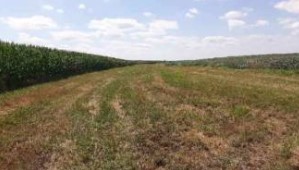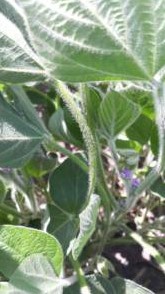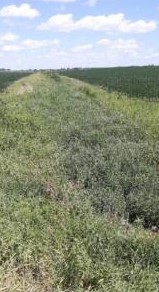By Lindsay Greiner
We’re in the heart of the long, hot days of summer, when our crops just grow in the heart of the U.S. Midwest. After having almost too much rain at times earlier in the summer, we’ve now had a few dry weeks, and are ready for some more rain.

Our soybeans are doing very well. They have grown knee-high or taller. About two weeks ago, we finished applying herbicide to control weeds, and our fields are clean so that the soybeans don’t have to compete with any weeds.
The soybeans have started blooming, which is growth stage R2. In the next week or two, the soybeans will start developing pods, reaching growth stage R3. At that point, we will treat some of our soybeans with a fungicide in an effort to boost plant health and increase yield. Some years, applying a fungicide pays off, and some years it doesn’t, so we usually treat some of our soybeans every year to manage that risk.

At the same time, we will keep an eye out for insects. If we have a bug infestation, we will treat to control them and protect the quality of our crop. We have to preserve soybean quality, and insects are the biggest threat to that at this time of year.
Our corn also looks good. It has just started tasseling. Based on crop reports from around the state of Iowa, corn is growing well everywhere.
Even the features in our field that we used to protect our soil and water quality are growing well. We have several wide grass waterways that run through our fields along the paths that rainwater takes as it moves from our fields to creeks. During harder rains like those we had earlier in the season, the rain that doesn’t soak into the soil moves into the waterways. The grass in the waterways filters out soil particles, preventing soil erosion. Recently, a neighboring farmer mowed and baled the grass on our waterways to sell as hay. He does the work, but since it is our ground, we split the sales.

We also have filter strips along creeks that we aren’t allowed to mow between May and August. The grass and wildflowers there provide pollinator habitat throughout this time of year. However, we will mow them in August primarily to control the young trees that have sprouted. We prefer to have natural grasses than trees in these strips to best filter excess nutrients and soil from the water that moves through these strips without interfering with crop growth.
We’ve also been hauling the soybeans and corn we grew in 2019 to the local elevator, the link in the supply chain that collects and stores commodities from farmers throughout the area. We are just finishing cleaning out our grain bins. We sweep and clean the bins out thoroughly to get them ready for the new crop we will harvest this fall. It’s a hot, dirty job, but it helps protect crop quality.
Our elevator is just 4 km, or 2.5 miles, from our main farm. We sell crops to the elevator, and from there, they are either sold to a processor or moved to the Mississippi River to be exported. Our local elevator usually sells export commodities to facilities in either Muscatine, Iowa, about 80 km, or 50 miles, east of us, or Burlington, Iowa, about 120 km, or 75 miles, away.
Click here to see more...